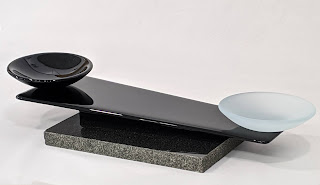Experimenting with Flexi-Glass Medium and Mica
 |
| Cabochon with bronze and gold mica |
In May, I joined other members of the Glass Art Guild of Utah in attending a class taught by David Alcala (see previous blog post). One of the techniques David taught us was using his Flexi-Glass Medium.
Flexi-Glass is a thick liquid that you paint on a non-stick sheet, sprinkle glass frit or powder over the sheet, and then fire in a kiln to create thin, flexible "glass" sheets. These sheets can be cut with scissors, easily torn, or punched, and then fired along with other fusible glass. This lets you create much more intricate shapes than you could ever cut by hand or with a ring saw. You can also mix the Flexi-Glass Medium with mica powders, spread the mixture on the non-stick sheet, and fire.
 |
| Flex-Glass Mica sheet |
In the photo on the right, you can see part of the Flexi-Glass sheet I created. I spread gold mica on one half of the sheet, bronze on the other, and then combined the two in the middle. Below left are the cabs ready to be fired -- I've used a colored glass for the base, placed mica cut-outs on top, and then capped with clear:
 |
| Cabochons waiting to be fired |
 |
| Cabochons, out of the kiln! |
I used a fairly "standard" (e.g., fast) firing schedule for the cabs.
The results are on the right.
I was somewhat concerned about the uneven texture of the mica sheet, and about what the pieces would look like after firing. I've had powdered mica "clump" on me, and I wondered if these sheets would do the same. However, I think the cabs turned out nicely. While I don't design a lot of jewelry these days, these little guys will probably end up as pendants.
I've currently got some larger pieces in the "big kiln" waiting for the kiln to be filled up so they can be fired. I'm concerned about bubbles near the mica sheet on larger pieces, so the largest piece right now has small glass chips at each of the four corners (fusers call these chads), to help air to escape during firing. The idea is the middle of the glass relaxes first, and then the glass relaxes outward, pushing air as it goes, resulting in fewer trapped air bubbles. I'll also make sure to include a nice long bubble squeeze in the firing schedule.
As always, I learned a few lessons with this experiment.
- I have (since) read that adding some alcohol to the Flexi-Glass/mica powder mixture helps with smoothing out the powder.
- I like more organic edges on the mica sheet, so next time, I won't spread it so neatly on the non-stick sheet.
- I should have cut my clear caps a little larger or the mica pieces a little smaller. I knew this, and did it anyway ;). If you look closely, you'll see some rough edges on the cabs as a result of the mica not being completely covered by the glass.
I'm going to continue to play with this technique. When the pieces in the big kiln are completed, I'll post some pictures. In the meantime, if you have any questions, let me know!
Happy fusing,
Dana
 |
| A finished cab using Flexi-Glass and mica powders. |

